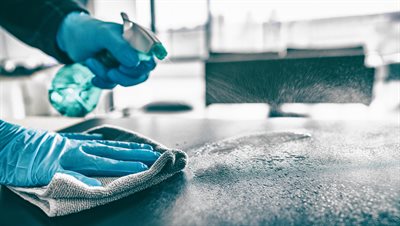Enhanced Cleaning and Disinfection Procedures for Virus Contamination
The infection risk from COVID-19 following contamination of the environment decreases over time. Current evidence suggests that the risk of infection significantly decreases after 72 hours has lapsed.
ENHANCED CLEANING: General recommendations for controlling the risk of infection
Routinely implement the “protect yourself from infection” detailed below during the COVID-19 emergency period.
- Public/communal areas where a symptomatic individual has passed through and spent minimal time in, and is not visibly contaminated with body fluids, can be thoroughly cleaned as normal (a chlorine based product will reduce viral loading most
 effectively)
effectively)
- Step up the frequency of routine cleaning in communal areas/facilities and high-contact areas such as: toilets; taps; door handles; hand rails; stairwells; telephones; TV remote controls; call buttons in lifts.
- Ensure that hand wash facilities are maintained with an adequate supply of liquid/foam soap and a hygienic means of hand drying is provided (i.e. disposable paper towels).
- Ensure disposable cloths, or paper towel, and disposable mop heads are used for cleaning. If not single use, they must be changed regularly.
- For cleaning equipment that is not single-use and disposable (i.e. buckets), ensure it is thoroughly cleaned and disinfected after use. Effective cleaning will not be achieved if dirty equipment is being used.
ENHANCED CLEANING (once a symptomatic person has left the setting or area)
INITIAL PREPARATIONS
- Identify all areas accessed by the symptomatic person.
- Ensure all necessary equipment and products are readily available and appropriate for use (i.e. cleaning equipment, appropriate PPE, chemicals and spillage packs). This should be identified by your risk assessment of the setting before cleaning and disinfection takes place.
- Always make the assumption that all body fluid contamination is infectious.
PROTECT YOURSELF FROM INFECTION
- As a minimum, wear disposable gloves and an apron to carry out cleaning.
- For areas visibly contaminated with body fluids, or where a higher level of virus may be present (such as a hotel bedroom where a symptomatic person has slept), additional PPE to protect the eyes, nose and mouth may be necessary.
Reference should be made to current Public Health Wales guidance on PPE requirements, or contact the Health Protection Team at Public Health Wales for guidance
DEALING WITH BODY FLUID CONTAMINATION
- For vomit and diarrhoea contamination, use granules provided with a spillage pack to soak up the contamination (follow instructions).
- Transfer the used granules and any solid matter directly into a waste bag – a scoop/scraper may be provided within the spillage pack.
- Do not shake dirty laundry or bedding that has been in contact with an unwell person to prevent the potential of dispersing the virus through the air.
- Anything used to transport laundry should be cleaned and disinfected afterwards.
- Dirty laundry that has been in contact with an unwell person can be washed in accordance with the instructions on the label.
CLEANING AND DISINFECTION PROCEDURE
- Initially clean visibly contaminated areas with detergent and hot water, using a disposable cloth. For areas where gross contamination has already been removed, ensure that an area 2 metres surrounding the contaminated area is also cleaned and disinfected.
- Avoid creating splashes and spray when cleaning.
- For items that cannot be laundered or cleaned with chemical products (i.e. upholstered furniture and mattresses), steam cleaning should be carried out.
- Disinfect all contaminated, and potentially contaminated areas/objects, with a freshly made solution of 1,000 parts per million (ppm) (0.1%) available chlorine product and apply for the contact time specified on the manufacturer’s instructions. Such products will include: bleach; Milton; Actichlor; TitanIf an alternative disinfectant is used in the organisation (e.g. quaternary ammonium compounds), check that they are effective against enveloped viruses.
- Dispose of all materials/items within the contaminated area that cannot be sufficiently cleaned and disinfected.• Undertake cleaning activities in a methodical manner so pre-cleaned surfaces do not become re-contaminated.
- Double bag and seal all used PPE; used disposable cleaning equipment and contaminated items. Securely store the waste for 72 hours before placing in your normal waste stream.
- Wash hands thoroughly using liquid soap and warm water for at least 20 seconds after PPE has been removed, and thoroughly dry them (preferably with paper towel that is immediately thrown away).
Contact Information
-
communicabledisease@cardiff.gov.uk
Further information about COVID-19 decontamination please click the links below: